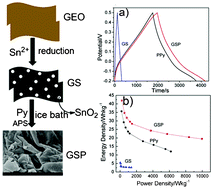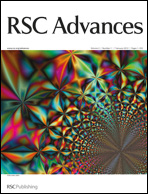Graphene/SnO2/polypyrrole ternary nanocomposites as supercapacitor electrode materials
Abstract
A ternary electrode material, based on graphene, tin oxide (SnO2) and polypyrrole (PPy) was obtained via one–pot synthesis. The graphene/SnO2/PPy (GSP) nanocomposite is composed of a thin conducting film of PPy on the surface of graphene/SnO2 (GS). An enhanced specific capacitance (616 F g−1) of GSP was obtained at 1 mV s−1 in 1 M H2SO4 compared with GS (80.2 F g−1) and PPy (523 F g−1). The GSP electrode shows better cycle stability and no obvious decay after 1000 galvanostatic cycles at 1 A g−1. Its specific power density and energy density can reach 9973.26 W kg−1, and 19.4 W h kg−1, respectively. The excellent electrochemical performance arises from the well-designed structure advantages, the good combination of components and the synergistic effect between the three components. Well-dispersed graphene is used as a framework for sustaining the pseudocapacitive materials of SnO2 and PPy. The PPy film restricts the aggregation and volume change of SnO2 during charge–discharge cycling, and also enhances the surface area. The electrochemical results show that the ternary composite of GSP is a promising candidate electrode material for high-performance supercapacitors.


 Please wait while we load your content...
Please wait while we load your content...